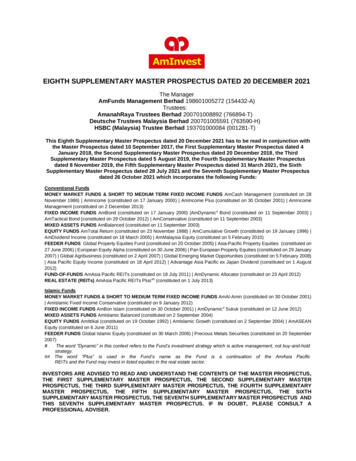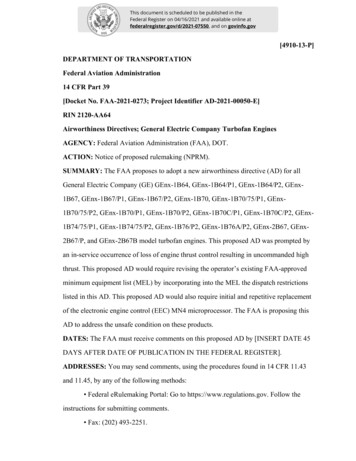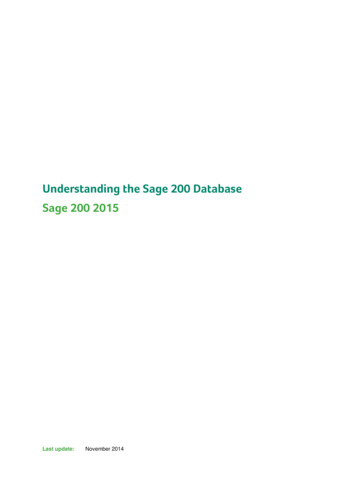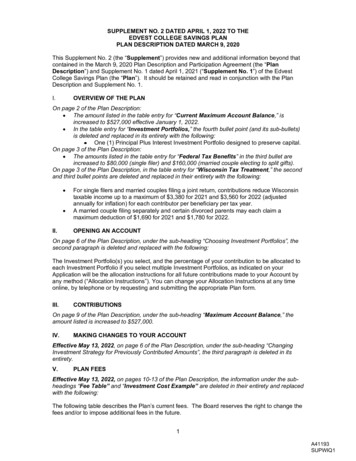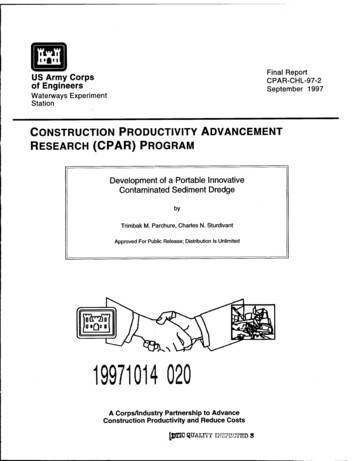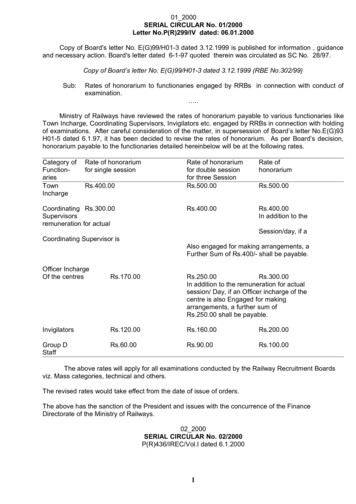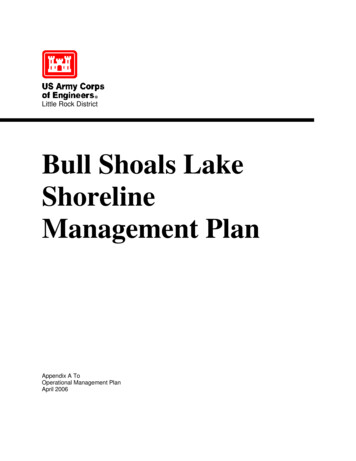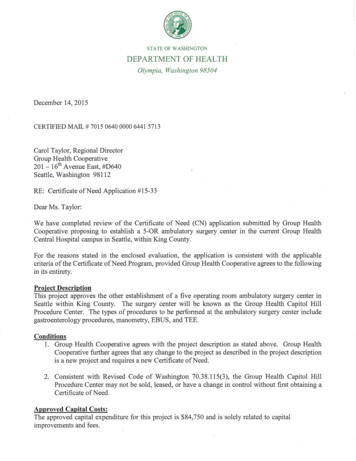
Transcription
EVALUATION DATED DECEMBER 14, 2015 OF THE CERTIFICATE OF NEEDAPPLICATION SUBMITTED BY GROUP HEALTH COOPERATIVE PROPOSINGTHE OTHER ESTABLISHMENT OF AN AMBULATORY SURGERY CENTER INCENTRAL KING COUNTYAPPLICANT DESCRIPTIONGroup Health Cooperative (GHC) was founded in Seattle in 1947 as a provider of prepaid healthcoverage and health care services through its own medical providers and facilities. GHC isregistered as a health maintenance organization (HMO) under state law, and continues to providemost of its Seattle area health care services to enrolled HMO members, at GHC owned andoperated facilities, and through providers who are employed directly by GHC or by its affiliatedmedical group, Group Health Permanente PC.1[source: application, p. 5]GHC is currently registered with both the Washington State Secretary of State office and theDepartment of Revenue. GHC is governed by a Board of Trustees elected by members orenrollees. GHC's corporate structure includes the following three separate corporations: GroupHealth Options, KPS Health Plans, and Columbia Medical Associates, LLC. [sources:Washington State Secretary of State and Washington State Department of Revenue websites;application, p. 5]“Group Health provides medical coverage and care to around 600,000 residents in WashingtonState and North Idaho who are covered by health plans offered by Group Health Cooperative orits subsidiaries, Group Health Options, Inc., and KPS Health Plans. Nearly two-thirds ofmembers receive care at Group Health Medical Centers.Group Health Cooperative, together with its subsidiary Group Health Options, Inc., operates inall or parts of 20 counties in Washington and two counties in North Idaho. In Washington,Group Health Cooperative offers coordinated-care plans for both groups and individuals andtheir Medicare Advantage plans.Care is provided by Group Health Physicians doctors and other clinicians and Group Healthoperated medical facilities. In service areas where Group Health doesn’t own facilities and for1Under RCW 70.38.025(7), a health maintenance organization means “a public or private organization,organized under the laws of the state, which:(a) Is a qualified health maintenance organization under Title XIII, section 1310(d) of the Public HealthServices [Service] Act; or(b) (i) Provides or otherwise makes available to enrolled participants health care services, including atleast the following basic health care services: Usual physician services, hospitalization, laboratory, Xray, emergency, and preventive services, and out-of-area coverage; (ii) is compensated (except forcopayments) for the provision of the basic health care services listed in (b)(i) to enrolled participantsby a payment which is paid on a periodic basis without regard to the date the health care services areprovided and which is fixed without regard to the frequency, extent, or kind of health service actuallyprovided; and (iii) provides physicians' services primarily (A) directly through physicians who areeither employees or partners of such organization, or (B) through arrangements with individualphysicians or one or more groups of physicians (organized on a group practice or individual practicebasis).Page 1 of 12
plans offering more choice, a network of nearly 9,000 community clinicians and 41 hospitalsmeet member health care needs.”[source: Group Health Cooperative website]As of the writing of this evaluation, GHC owns and operates one acute care hospital in Seattle,two ambulatory surgery centers (Bellevue and Tacoma), and approximately 25 full-serviceclinics throughout the state. The hospital, known as Group Health Central Hospital, is currentlyoperating and is licensed for 326 acute care beds. GHC plans to relinquish the hospital licensefor Group Health Central Hospital in early 2016. With the closing of Group Health CentralHospital, inpatient services for Group Health enrollees in King County will be provided bySwedish Health Services. Outpatient surgical services will remain on-site in two free-standingambulatory surgery centers. One surgery center, known as the Group Health Capitol HillAmbulatory Surgery Center, has 11 operating rooms and obtained Certificate of Need approvalon November 20, 2015 (CN #1559). The second surgery center is the focus of this project andwill be known as the Group Health Capitol Hill Procedure Center.[sources: application, pp. 14-15; Group Health Cooperative Year 2014 Annual Hospital LicenseApplication; CN #1559 evaluation p. 2]PROJECT DESCRIPTIONGHC currently owns and operates Central Hospital, a licensed, accredited, Medicare-certifiedgeneral acute care hospital at 201 - 16th Avenue East on the Capitol Hill campus in Seattle,Washington. Central Hospital includes a procedure center with 5 operating rooms 2 , oneadmitting area room with 2 stretchers, and one room with 7 bays for post procedure recovery anddischarge. The services provided in these operating rooms are restricted to gastroenterologicalprocedures, manometry3, EBUS4, and TEE5.[source: application, p. 10]2Throughout the application, Group Health refers to these operating rooms as “procedure rooms.” For the purposesof Certificate of Need, operating rooms (ORs) and procedure rooms (PRs) are the same, and the terms will be usedinterchangeably throughout this evaluation.3“Manometry,” according to the U.S. National Library of Medicine is “a test to measure how well the esophagus isworking. During esophageal manometry, a thin, pressure-sensitive tube is passed through your nose, down theesophagus, and into your stomach. After the tube is in the stomach, the tube is pulled slowly back into youresophagus. At this time, you are asked to swallow. The pressure of the muscle contractions is measured alongseveral sections of the tube. While the tube is in place, other studies of your esophagus may be done. The tube isremoved after the tests are completed. The test takes about 1 hour.” [source: www.nlm.nih.gov/medlineplus]4“EBUS” means Endobronchial Ultrasound Bronchoscopy. According to the American Lung Association, “Forendobronchial ultrasound, a bronchoscope (a thin, lighted, flexible tube) is fitted with an ultrasound device (adevice that uses sound waves to make pictures of the inside of your body) at its tip. It is passed down into thewindpipe to look at nearby lymph nodes and other structures in the chest. This is done with numbing medicine (localanesthesia) and light sedation. A hollow needle can be passed through the bronchoscope and guided by ultrasoundinto an area of concern to take biopsy samples.” [source: www.lung.org]5“TEE” means transesophageal echocardiography. According to the American Heart Association, TEE is “a testthat produces pictures of your heart. TEE uses high-frequency sound waves (ultrasound) to make detailed picturesof your heart and the arteries that lead to and from it. Unlike a standard echocardiogram, the echo transducer thatproduces the sound waves for TEE is attached to a thin tube that passes through your mouth, down your throat andinto your esophagus. Because the esophagus is so close to the upper chambers of the heart, very clear images ofthose heart structures and valves can be obtained.” [source: www.heart.org]Page 2 of 12
This project focuses on conversion of the hospital procedure center into a free-standingambulatory surgery center with the closing of Central Hospital. While the physical space alreadyexists and provides outpatient surgical services6, the current entity (the hospital) will close, andwill reopen as a new healthcare facility – a separately licensed ambulatory surgery center. TheASC will be licensed and accredited, and will be called the Group Health Capitol Hill ProcedureCenter. The intent is to provide the surgical services in an ASC service model, consistent withGHC’s longstanding methods of operation in delivering coordinated care to its members.[sources: application, p. 2, Group Health Cooperative Year 2014 Annual Hospital LicenseApplication; and Group Health Cooperative website]GHC has operated the procedure center under the hospital license in its current location foralmost 20 years, and intends to maintain the number of procedure rooms, and the types ofprocedures performed.[sources: application, p. 10]The estimated capital expenditure associated with the project is 84,750 and is solely related tothe capital improvements required for licensure.[source: application, p. 11]If this project is approved, GHC anticipates it would begin to offer services as a CN approvedASC immediately. Under this timeline, 2016 would be the first full year of operation and year2018 would be the third full year of operation.[source: application, p. 1]APPLICABILITY OF CERTIFICATE OF NEED LAWThis project is subject to Certificate of Need review as the other establishment of a new healthcare facility under the provisions of Revised Code of Washington (RCW) 70.38.105(4)(a) andWashington Administrative Code (WAC) 246-310-020(1)(a).EVALUATION CRITERIARevised Code of Washington (RCW) 70.38.115(3) limits the criteria the department uses in itsreview of an HMO facility. The statute also prohibits the sale, lease, or change in controllinginterest of an entity granted a CN under this statutory provision without first obtaining a CNapproving the sale, acquisition or lease. WAC 246-310 does not contain service or facilitystandards for an HMO project.6“Surgical Services” as defined in WAC 246-330-010(47) means “invasive medical procedures that:(a) Utilize a knife, laser, cautery, cytogenics, or chemicals; and(b) Remove, correct, or facilitate the diagnosis or cure of disease, process or injury through that branch of medicinethat treats diseases, injuries and deformities by manual or operative methods by a practitioner.”Further, per WAC 246-330-010(20) an “invasive medical procedure” means “a procedure involving puncture orincision of the skin or insertion of an instrument or foreign material into the body including, but not limited to,percutaneous aspirations, biopsies, cardiac and vascular catheterizations, endoscopies, angioplasties, andimplantations. Excluded are venipuncture and intravenous therapy.” [emphasis added]Page 3 of 12
TYPE OF REVIEWThis application was reviewed under the regular review timeline outlined in WAC 246-310-160,which is summarized below.APPLICATION CHRONOLOGYActionLetter of Intent SubmittedApplication SubmittedDepartment’s Pre-Review Activities Department 1st Screening Letter Sent GHC’s 1st Screening Responses Received Department 2nd Screening Letter Sent GHC’s 2nd Screening Responses ReceivedDepartment Begins Review of the Application public comments accepted throughout review; no public hearing requested or conductedEnd of Public CommentRebuttal Comments DueDepartment's Anticipated Decision DateDepartment's Actual Decision DateGroup Health Cooperative ASCMay 5, 2015June 9, 2015June 30, 2015August 14, 2015September 4, 2015October 19, 2015October 26, 2015November 30, 2015December 15, 2015January 29, 2016December 14, 2015AFFECTED PERSONSWashington Administrative Code 246-310-010(2) defines “affected person” as:“ an “interested person” who:(a) Is located or resides in the applicant's health service area;(b) Testified at a public hearing or submitted written evidence; and(c) Requested in writing to be informed of the department's decision.”As noted above, WAC 246-310-010(2) requires an affected person to first meet the definition ofan ‘interested person.’ WAC 246-310-010(34) defines “interested person” as:(a) The applicant;(b) Health care facilities and health maintenance organizations providing services similar tothe services under review and located in the health service area;(c) Third-party payers reimbursing health care facilities in the health service area;(d) Any agency establishing rates for health care facilities and health maintenanceorganizations in the health service area where the proposed project is to be located;(e) Health care facilities and health maintenance organizations which, in the twelve monthsprior to receipt of the application, have submitted a letter of intent to provide similarservices in the same planning area;(f) Any person residing within the geographic area to be served by the applicant; and(g) Any person regularly using health care facilities within the geographic area to be servedby the applicant.For this application, two entities sought interested person status and requested that copies of allinformation regarding the application be provided to them throughout the course of review. ThePage 4 of 12
two entities are Swedish Health Services, and MultiCare Health System. Below are summariesof each and a determination of their respective status regarding this application.Swedish Health ServicesSwedish Health Services is a non-profit health care provider that operates five hospital campuses– three of which are located in King County. Beginning in 2016, Swedish will be the primaryhospital provider for inpatient services for adult Group Health HMO members. Swedish isaffiliated with Providence Health and Services.MultiCare Health SystemMultiCare is a non-profit health care organization that serves Pierce, King, Thurston, and Kitsapcounties. In King County, MultiCare has a hospital campus in Auburn, urgent care services inFederal Way and Kent.Both of these entities qualified as interested persons under WAC 246-310-010(34). The secondrequirement to be recognized as an affected person is to submit written comment or to testify at apublic hearing. Since no public hearing was conducted, each requesting entity needed to submitwritten comments to qualify under WAC 246-310-010(2). Neither of the requesting entitiessubmitted public comment throughout the course of review. As a result, neither of these entitiesmet the criteria to be an “affected person.”SOURCE INFORMATION REVIEWED Group Health Cooperative Certificate of Need Application received on June 9, 2015 Supplemental information received on August 14, 2015 Supplemental information received on October 19, 2015 Licensing data provided by the Department of Health’s internal database, IntegratedLicensing & Regulatory System, “ILRS” Group Health Cooperative website at www.ghc.org Washington State Secretary of State website at www.sos.wa.gov Washington State Department of Revenue website at www.dor.wa.gov Certificate of Need historical filesCONCLUSIONFor the reasons stated in this evaluation, the application submitted by Group Health Cooperativeto establish an ambulatory surgery center in central King County is consistent with the applicablereview criteria, provided Group Health Cooperative agrees to the following in its entirety.Project DescriptionThis project approves the other establishment of a five operating room ambulatory surgery centerin Seattle within King County. The surgery center will be known as the Group Health CapitolHill Procedure Center. The types of procedures to be performed at the ambulatory surgery centerinclude gastroenterology procedures, manometry, EBUS, and TEE.Page 5 of 12
Conditions1. Group Health Cooperative agrees with the project description as stated above. GroupHealth Cooperative further agrees that any change to the project as described in theproject description is a new project and requires a new Certificate of Need.2. Consistent with Revised Code of Washington 70.38.115(3), the Group Health CapitolHill Procedure Center may not be sold, leased, or have a change in control without firstobtaining a Certificate of Need.Approved CostsThe approved capital expenditure for this project is 84,750 and is solely related to capitalimprovements and fees.Page 6 of 12
CRITERIA DETERMINATIONSA. RCW 70.38.115(3)(a)Based on the source information reviewed and provided the applicant agrees to the conditionsstated in the ‘conclusion’ section of this evaluation, the department determines Group HealthCooperative met the applicable criteria set forth in RCW 70.38.115(3)(a).Revised Code of Washington 70.38.115(3)(a) provides only the following guidance forreviewing applications submitted by an HMO. It states:"A certificate of need application of a health maintenance organization or a healthcare facility which is controlled, directly or indirectly, by a health maintenanceorganization, shall be approved by the department if the department finds:(a) Approval of such application is required to meet the needs of the members ofthe health maintenance organization and of the new members which suchorganization can reasonably be expected to enroll”WAC 246-310 does not provide specific review criteria for an HMO operated or controlled ASC.Therefore, the department reviewed the arguments and data provided by the applicant.Applicant’s DataGHC provided the following statement related to this project. “The conversion of GHC’sCentral Hospital Procedure Center to a freestanding ASC is part of GHC’s overall strategicinitiative to change the manner in which hospital and other acute care services are furnished toGHC members in the Seattle metropolitan area.” GHC adapted the ambulatory surgery centermethodology found in WAC 246-310-270 that is used for projecting need of non-HMOambulatory surgery ORs. They applied this adapted methodology to their own enrolleepopulation for the purpose of demonstrating need in their application. The adapted methodologyprojects a numeric need for five procedure rooms and is shown on the following page in Table 1.Four of these rooms are designated for gastroenterological procedures, and one has beendesignated for EBUS and TEE (labeled as “gastro” and “pulm,” respectively).[sources: application, p. 14; August 14, 2015 supplemental information, p. 11]Page 7 of 12
Table 1Group Health Projected Need for 5 Procedure Rooms (PR) Using Adapted ASCMethodologyCriteriaGHC Data Used4 Gastro Rooms 1 Pulm RoomExisting CapacityAnnual Capacity per PR (68,850 min/room)275,400 minutes 68,850 minutesAverage Minutes per Procedure30 minutes73 minutesAnnual Capacity for Procedures9,180 procedures 943 proceduresFuture NeedActual 2014 Procedures4,911 procedures 144 proceduresAdd manometry procedures @ 30 min each104 proceduresn/aProjected 6% growth in enrollees in 3 years301 procedures9 proceduresProjected 2.25% outpatient procedure increase in 3years110 procedures3 proceduresAdd scheduled but cancelled procedures @ 6%326 procedures9 proceduresTotal adjusted projected PR procedures in 3rd year 5,752 procedures 165 proceduresSubtract projected procedures from capacity3,428 procedures 778 proceduresConvert procedures to procedure minutes102,840 minutes 56,794 minutesNet NeedDivide procedure room need/surplus minutes bysingle procedure room capacity1.49 PR surplusTotal Minimum Need, Rounded Up3 PRsBackup PR0.5 PRCoordinated Care PR0.5 PRTotal PR Needed4 PRs[source: August 14, 2015 supplemental information, p. 11]0.8 PR surplus1 PRn/an/a1 PRTo further demonstrate adherence to the criteria in RCW 70.38.115(3)(a), GHC states that itrequires at least one backup procedure room in addition to the three justified by the adaptednumeric need methodology. GHC currently operates 8 gastroenterology procedure rooms inSeattle and Bellevue. In the event that one or more procedure rooms at those locations becomeunavailable because of equipment or systems problems or other reasons, good practice requiresGHC to keep a backup procedure room available in order to maintain to the extent possible itsregular outpatient surgery schedule and access.Additionally, care coordination in the GHC care model requires more than the minimum numberof ORs projected by the adapted need methodology for non-HMO ASCs. GHC provided thefollowing example of care coordination: “Care coordination in the gastroenterology procedureroom setting requires having pairs of rooms available for scheduling with individual providers.For example, having two pairs of procedure rooms allows two physicians to perform proceduresin a highly efficient and cost-effective manner. GHC will set up one room for a patient while thePage 8 of 12
physician is performing a procedure with another patient in another room. When the physiciancompletes the procedure and cleanup begins, the physician can switch to the paired procedureroom to begin another procedure with another patient, and so on during the daily schedule. Thispaired approach to scheduling and utilization is highly efficient and allows physicians and otherproviders to perform more procedures each day, thus reducing the cost of each procedure.Maintaining the current number of 4 gastroenterology rooms would provide two room pairs forcoordinated scheduling.”[source: application, p. 20]Department’s ReviewSince there are no adopted standards for the review of an HMO owned or controlled ASC, thedepartment’s review will focus on the reasonableness of the assumptions and modifications thatGHC made to the existing non-HMO methodology in their request for 5 operating rooms. Forreader ease, Table 1 has been replicated on the next page, with department comments following:Table 1Group Health Projected Need for 5 Procedure Rooms (PR) Using Adapted ASCMethodologyCriteriaGHC Data Used4 Gastro Rooms 1 Pulm RoomExisting CapacityAnnual Capacity per PR (68,850 min/room)275,400 minutes 68,850 minutesAverage Minutes per Procedure30 minutes73 minutesAnnual Capacity for Procedures9,180 procedures 943 proceduresFuture NeedActual 2014 Procedures4,911 procedures 144 proceduresAdd manometry procedures @ 30 min each104 proceduresn/aProjected 6% growth in enrollees in 3 years301 procedures9 proceduresProjected 2.25% outpatient procedure increase in 3years110 procedures3 proceduresAdd scheduled but cancelled procedures @ 6%326 procedures9 proceduresTotal adjusted projected PR procedures in 3rd year 5,752 procedures 165 proceduresSubtract projected procedures from capacity3,428 procedures 778 proceduresConvert procedures to procedure minutes102,840 minutes 56,794 minutesNet NeedDivide procedure room need/surplus minutes bysingle procedure room capacity1.49 PR surplusTotal Minimum Need, Rounded Up3 PRsBackup PR0.5 PRCoordinated Care PR0.5 PRTotal PR Needed4 PRs[source: August 14, 2015 supplemental information, p. 11]Page 9 of 120.8 PR surplus1 PRn/an/a1 PR
The applicant used existing patient origin data and actual number of surgeries to establisha use rate. This substitution is acceptable.Rather than using a set planning area population, GHC instead used actual numbers ofenrollees who have received surgical care at the hospital outpatient surgery department.The applicant then assumed two rates of increase over three years – 6% enrollmentincrease and 2.25% utilization increase.o GHC originally projected a 12% increase in enrollment. Through screening, thedepartment questioned the 12% increase in enrollment assumption because it was notconsistent with historical figures. Subsequently, GHC provided a more modestprojected increase of 6% over the next three years, and asserted that throughsignificant cost-cutting measures they will be more attractive to potential enrollees.The 6% enrollment increase projection is reasonable.[source: July 17, 2015 supplemental information, p. 10]o GHC originally projected a 4.5% utilization increase among enrollees. This isconsistent with historical data provided by the applicant. Since 2009, the use rateamong enrollees has increased by 16%. In response to screening, GHC reduced theanticipated utilization increase. This modest assumption of continued growth –2.25% over the course of 3 years – is reasonable.[source: August 14, 2015 supplemental information, p. 11]The applicant included a further 6% of procedures in their methodology that arescheduled, but then cancelled. In response to screening, GHC provided 6 months of datathat demonstrates that between 6 and 8% of procedures were either cancelled within 24hours or did not take place because the patient did not arrive. Due to the nature of theprocedures performed in these operating rooms and the associated “lengthy anduncomfortable preparation at home” prior to the procedure, GHC asserts that theseunfilled time slots cannot be refilled. This assumption can be substantiated and isreasonable.[sources: application, p. 19-20; August 14, 2015 supplemental information, pp. 8-9]The department agrees that the assumptions GHC made in their adapted methodology can besubstantiated and demonstrates numeric need for 4 ORs.The rationale presented by GHC states non-numeric need for an additional OR for a total of 5.Under ordinary circumstances, ORs beyond those projected in the numeric need would not beapproved. However, in accordance with WAC 246-310-210(5), “[this] project is needed to meetthe special needs and circumstances of enrolled members or reasonably anticipated newmembers of a health maintenance organization.” GHC identified several different reasons forconverting all of its 5 outpatient ORs at GHC Central Hospital to a freestanding ASC. Thesereasons are not unique to Group Health. However, this proposed project maintains the currentlevel of access to outpatient surgery at a Group Health facility for enrollees in the greater KingCounty area. Therefore, the rationale presented by GHC for the additional OR, for a facility totalof 5 is reasonable.Based on the source information evaluated the department concludes that this criterion is met.Page 10 of 12
B. RCW 70.38.115(3)(b)Based on the source information reviewed and provided the applicant agrees to the conditionsstated in the ‘conclusion’ section of this evaluation, the department determines Group HealthCooperative met the applicable criteria set forth in RCW 70.38.115(3)(b).Revised Code of Washington 70.38.115(3)(b) provides only the following guidance forreviewing applications submitted by an HMO. It states:"A certificate of need application of a health maintenance organization or a healthcare facility which is controlled, directly or indirectly, by a health maintenanceorganization, shall be approved by the department if the department finds:(b) The health maintenance organization is unable to provide, through services orfacilities which can reasonably be expected to be available to the organization,its health services in a reasonable and cost-effective manner which is consistentwith the basic method of operation of the organization and which makes suchservices available on a long-term basis through physicians and other healthprofessionals associated with it.”WAC 246-310 does not provide specific review criteria for an HMO operated or controlled ASC.Therefore, the department reviews the arguments and data provided by the applicant.Applicant’s DataGroup Health distinguishes itself as an HMO that provides the full spectrum of health careservices and healthcare coverage on a pre-paid basis. They do this using their own employedand closely affiliated providers and staff – and as often as possible use their own facilities to helpcontrol costs. They assert that this integrated model of services allows for system efficiency,greater patient satisfaction, and less expense.[source: application, pp. 27-29]If this was a traditional ambulatory surgery facility application, the intent of this section wouldbe to ensure that the project is the most cost-effective option after a thorough review ofalternatives. In this case, rather than providing fully formed alternative options, GHC insteadprovided examples of services and efficiencies that the ASC will have that would not beavailable if the project changed GHC’s standard method of operating outpatient surgery services.They are listed as follows: The provision of coordinated care across the continuum is a key element of the highquality care provided to Group Health consumers. Reliance on other ASC resourceswould diminish our ability to provide coordinated care and achieve quality goals.Our ability to control costs, quality and safety would diminish if services are providedoutside of Group Health facilities.Scheduling and coordinating care between Group Health ambulatory care clinics and avariety of procedure centers would add needless complexity to systems and processes.The added complexity would diminish our ability to coordinate care and would raiserisks of service quality and patient safety issues.Page 11 of 12
Our ability to use Epic, our integrated health record system, for the seamlesscoordination of care for procedures would be diminished, compromising our ability tocoordinate care and continue to achieve our high quality standards.Group Health patients expect and are accustomed to receiving procedure care at GroupHealth owned and operated facilities. Referrals to other ASCs would significantlydiminish the customer experience at Group Health, potentially leading to the loss ofGroup Health members.Group Health costs of care would increase and efficiencies would diminish if GroupHealth Physicians were required to perform procedures in procedure centers not on theGroup Health Capitol Hill Campus, where their offices are located.Group Health costs of care would increase if ASC procedures are performed in ahospital based surgery center, because an additional facility fee would be imposed.Will take a significant amount of time and resources to plan for and execute a completechange in the provision of procedures at GH.Will result in layoffs of a significant number of healthcare team members currentlyproviding procedure care to GH patients.[source: application, pp. 28-29]Department’s ReviewOnce GHC made the decision to close Group Health Central Hospital, their options forcontinuing to provide outpatient surgical services were limited to the following: To change the existing care structure for outpatient surgery and potentially increase costsby only providing outpatient surgical services through contracted ASCs and hospitals; orTo establish a new location for the freestanding ambulatory surgery center.The department agrees that the option of changing the structure of existing ou
Health Options, KPS Health Plans, and Columbia Medical Associates, LLC. [sources: Washington State Secretary of State and Washington State Department of Revenue websites; application, p. 5] "Group Health provides medical coverage and care to around 600,000 residents in Washington State and North Idaho who are covered by health plans offered .
